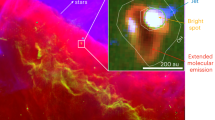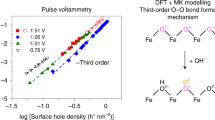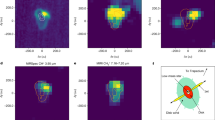Abstract
MEASUREMENTS made recently at Berkeley have shown that there is interstellar OH absorption in most low latitude radio sources1. Most indications are that the excitation, unlike that in the intensely emitting regions2, is fairly normal, and that the state temperature is T < 10° K. If it is assumed that T = 3° K (a minimum value, from the cosmic microwave background), the median value of OH/H is about 4 × 10−8 in sources in which both OH and H lines can be measured. This ratio, which corresponds to OH/O ∼ 6 × 10−5, is not far from that of CH and CH+, seen optically. An attempt by Bates and Spitzer to explain the abundance of CH by two body radiative association3 failed by more than three orders of magnitude. This led Stecher and Williams4 to propose that chemical exchange reactions on grains of the form GX + Y→G + XY (where X = H, Y = O for OH) could operate in the heated regions behind interstellar shock fronts. They calculated that OH/H = 3 × 10−9 after a shock passes. Photodissociation (τ = 104 yr) between shock passages (T = 107 yr) reduces OH/H to an average value of 3 × 10−12, which is four orders of magnitude too low. According to Carroll and Salpeter5, the chemical exchange reaction O + H2→OH + H produces comparable amounts of OH if H2/H ∼ 10−4. According to Stecher and Williams6, however, H2/H is kept to the extremely low value of 10−7 by photodissociation of H2.
This is a preview of subscription content, access via your institution
Access options
Subscribe to this journal
Receive 51 print issues and online access
$199.00 per year
only $3.90 per issue
Buy this article
- Purchase on SpringerLink
- Instant access to full article PDF
Prices may be subject to local taxes which are calculated during checkout
Similar content being viewed by others
References
Goss, W. M., Astrophys. J., Suppl., No. 137 (1968).
Robinson, B. J., and McGee, R. X., Ann. Rev. Astro. Astrophys., 5, 183 (1967).
Bates, D. R., and Spitzer, jun., L., Astrophys. J., 113, 441 (1951).
Stecher, T. P., and Williams, D. A., Astrophys. J., 146, 88 (1966).
Carroll, T. O., and Salpeter, E. E., Astrophys. J., 143, 609 (1966).
Stecher, T. P., and Williams, D. A., Astrophys. J., 149, L29 (1967).
Solomon, P. M., Nature, 217, 334 (1968).
Field, G. B., Rather, J. D. G., Aannestad, P. A., and Orszag, S. A., Astrophys. J., 151 (in the press, 1968).
Spitzer, jun., L., Stars and Stellar Systems (edit. by Kuiper, G., and Middlehurst, B.), 7, chap. 9 (University of Chicago Press) (in the press, 1968).
Lambrecht, H., and Zimmermann, H., Mitt. Univ. St. Jena, No. 14 (1956)
Author information
Authors and Affiliations
Rights and permissions
About this article
Cite this article
FIELD, G., AANNESTAD, P. & SOLOMON, P. Production of OH Molecules in Interstellar Shock Waves. Nature 217, 435–437 (1968). https://doi.org/10.1038/217435a0
Received:
Published:
Issue date:
DOI: https://doi.org/10.1038/217435a0
This article is cited by
-
Protostars as Sources of Anomalous OH Emission
Nature (1968)



